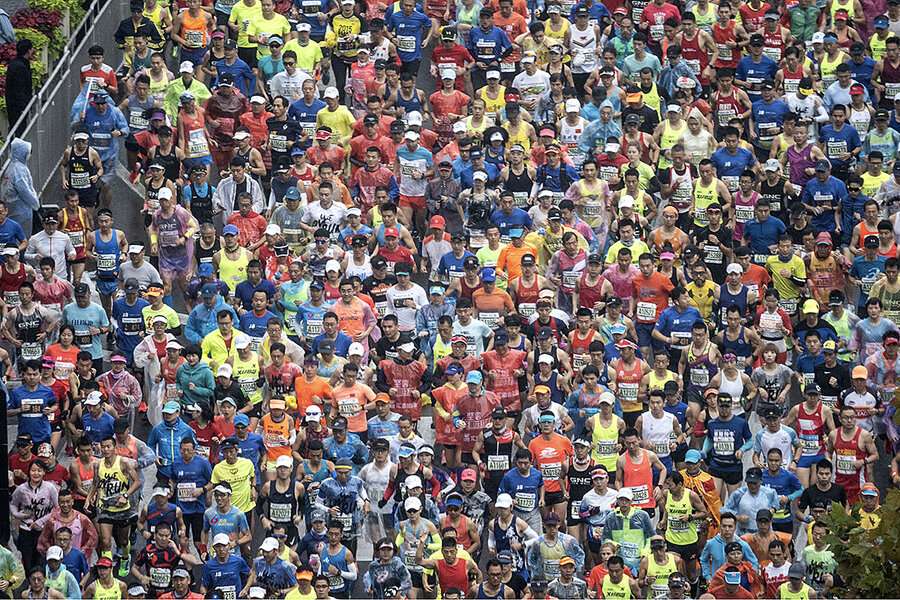China sprints toward next sports goal: half a billion weekend warriors
Loading...
| Shanghai, China
Think about consumer culture in China, and you might picture luxury bags and watches. But what about running shoes and road bikes? Over the past decade, the country’s middle class has embarked on a fitness renaissance, with spending on sports apparel poised to surpass that on luxury goods by 2020. Meanwhile, the government is incentivizing investment and pumping up spending for athletic facilities and infrastructure. Related policies call for 20,000 soccer schools and a sports industry worth $720 billion. Yet ambition is sometimes boxed in by obstacles unique to the world’s fastest-growing major economy, such as pollution. There are basic limitations, too, like space and lack of coaches. “Balancing work, body, and mind was always part” of the Chinese consciousness, says Henry Shen, McCann Health’s chief strategy officer for Greater China. The Chinese elders dancing and performing tai chi in every park are proof, he says. “It just got lost during the fast development of the economy.” Even now, he remembers first walking by the yoga studio he now belongs to and being struck by its slogan: “Slow is the new fast.”
Why We Wrote This
During decades of intense economic growth, many Chinese feel wellness – both personal and environmental – was put on the back burner. Today, balance is actually being written into national goals.
Steeling herself against a light drizzle, Linda Liu corrals herself into Area E at the Shanghai Marathon starting line, mobile phone strapped to her upper arm.
Around the first bend, traditional tanggu drummers dressed in red and gold await the race start, their steady beats ready to echo the pitter-patter of the 25,000 runners who would flow past.
The start of the Shanghai Marathon is pure aspiration, like the majestic skyline of the Bund waterfront where it begins, home to city’s most iconic buildings and modern skyscrapers.
Why We Wrote This
During decades of intense economic growth, many Chinese feel wellness – both personal and environmental – was put on the back burner. Today, balance is actually being written into national goals.
In the two decades since launch, the Shanghai Marathon has come to attract top athletes from overseas, alongside the thousands of Chinese who managed to draw a race number.
“I’m ready. I feel carefree,” Ms. Liu says. The property manager has no hope of placing, but something to prove to herself: “That I can run an entire marathon.”
Over the past decade, China’s middle class has embarked on a fitness renaissance, with spending on fitness apparel poised to surpass luxury goods by 2020. That’s a seismic shift in a country where urban consumers nursed a Prada obsession for years. Now, it’s running shoes and road bikes. About 75 percent of urban Chinese participate in sports and fitness, driven by newfound health awareness, social media, and the marketing reach of the behemoth $300-billion fitness industry.
Individual athletes aren’t the only ones with something to prove. As China launches onto the world stage, the next phase of its evolving quest encompasses sport: from high-profile international events to ambitious plans to produce legions of student-athletes. Yet those campaigns must overcome obstacles unique to the world’s fastest-growing major economy, such as pollution and an education culture that often prioritizes mind over body.
“Balancing work, body, and mind was always part” of the Chinese consciousness, says Henry Shen, McCann Health’s chief strategy officer for greater China. The Chinese elders dancing and performing tai chi, fixtures of every park in China, are proof, Mr. Shen says.
“It just got lost during the fast development of the economy,” he says. Shen himself is a member of yoga studio Y+. The club’s slogan immediately struck a chord as he walked by years ago, he says, wonder in his voice even today as he recalls it: “Slow is the new fast.”
Indeed, “fast” has been the norm for a country accustomed to double-digit growth. But as middle-class consumers have come into money, they’ve begun trading in luxury logos for a status symbol that calls for more than plunking down a bundle of renminbi notes.
“Twenty years ago, young Chinese were about making money and surviving, building up their lives and learning English,” says English ultramarathoner Harriet Gaywood, who notes that over her two decades living and training in China, she’s joined by more and more Chinese athletes. “Today it’s about becoming healthy.”
That desire for fitness is helped along by that disposable income, enabling sports and access in a powerful combination. As the Chinese spend money on fitness memberships, sports equipment, and private cars, new sports come within reach: swimming, Pilates, even trail running in the countryside.
Dropping the ball?
Meanwhile, the government is placing its heft behind fitness, incentivizing investment and pumping up spending for facilities and infrastructure.
In 2014, the State Council issued File No. 46, which boldly declared a plan to anoint China’s sports industry tops in the world. The Council tied the health of the people to development of the country and economy, and it also slapped a number on the goal: a sports industry that would be 5-trillion-renminbi strong ($720 billion), with half a billion participants by 2025.
Several dozen policies followed, including a vision for a national soccer team to compete at the highest levels by 2050, with a pipeline of 30 million young players and 20,000 soccer schools.
“China feels it needs to be on the world stage, and you need a plan to do that,” says Jeffrey Wilson, chair of the board at Active Kidz Shanghai, a community team sports organization.
Schools also play a role, with required physical education classes raising “the importance of fitness to the will of a nation,” said Kobe Li, a sports administrator at a Shanghai kindergarten.
Yet ambition is sometimes boxed in by the most basic of limitations: space. As developers erected Chinese cities skyward, planning officials neglected to devote open space and parks for sport. Where a precious patch of grass does exist, battles ensue over its usage. “Security guards always shoo the kids away when they play ball,” one Shanghai parent said of the tennis court-sized lawn shared by 1,000 residents in her complex.
“They say they want to protect the grass.”
Then there’s the problem of trainers. “Local schools are under pressure to provide more, but they often don’t have the venues or the coaches,” says Wilson of Active Kidz. China lacks the pipeline of volunteers to pick up the slack, but that’s slowly changing. Wilson is starting to find talent in unexpected places. “Fudan University has a baseball team, did you know?” he says, speaking of the Shanghai school that is one of China’s best. “We have had some parents who played baseball there, and now they want their kids to start earlier.”
Pollution also limits time spent outdoors — at least a few times a month, Ms. Liu cancels workouts after checking the air quality index — while an education-steeped culture prioritizes intellectual achievement. One runner said he can only take his daughter for a workout after he checks her homework load, which for Chinese students is double the global average at nearly three hours daily.
Chinese cultural beliefs can work against running fast or sweating hard, too. “Don’t go to public places too often. Exercise, but not too strenuously,” trumpeted a development guide used by Shanghai kindergarten teachers.
Sometimes, government officials foil the very sporting ambitions they aim to promote. Early this month, ticket sales to the national soccer championship game in Shanghai were shut down over security concerns. About half the 60,000 seats were left empty.
One step at a time
Yet China’s No. 1 sport doesn’t need equipment or even stadiums. Running, according to a 2017 Nielsen survey, is becoming a national pastime. The number of races held nationwide is expected to reach nearly 2,000 by 2020, a doubling in just three years, according to the Chinese Athletic Association.
For Ms. Liu, back at the Shanghai Marathon, her running aspirations had started small – piqued by WeChat, China’s ubiquitous messaging platform.
“A friend posted a snapshot of his stopwatch; he did 10 kilometers [6.2 miles] in 56 minutes,” she laughed, speaking to me at a teahouse in Shanghai a week before the race. “I thought I could do better. He runs on flats — I’ve been practicing on slopes.”
Ms. Liu was right. She immediately took to jogging in her pink Adidas, already broken in from 6 a.m. group workouts she started. Within a few months, she’d bested her friend. The Chinese might say her heritage was a competitive advantage; she hailed from Hunan province, known for its steep terrain and a history of producing some of China’s hardiest soldiers.
The day of the marathon, Linda felt unwell, while the race route itself was beset by rain. “There were puddles. I feel a little regretful — I was trying to finish in four hours,” Linda said later, of her finishing time that exceeded her goal by six minutes. “I’ll take two days off, and head back to [training].”
Shanghai entrepreneur Larry Yin sent messages after the race filled with happy-face emoticons. “I completed the marathon slowly and safely,” he said, in a “humblebrag” for his fastest time yet. While training over the past few years, Mr. Yin had lost 90 pounds, a remnant of his management consulting days, and he’s run five marathons now.
Yet he’s most proud to educate his 10 year-old daughter about the importance of fitness. “She sees her daddy get up every day and run, whether it’s winter, summer, fall, or spring,” Mr. Yin says. “That’s what I want to pass to her.”








